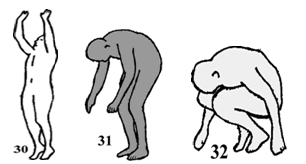Course XVIII - Teaching 3: Anatomical-Functional Gymnastics
Relaxation exercises
Relaxation exercises are distributed among the following groups of exercises, but also can be practiced irrespective of other gymnastics. You should breathe regularly during their practice. Exercises referred to one member, should be inverted and also practiced with the other member.
Arms
- Both arms relaxed through shoulder drive. Lateral position, loose and relaxed body, arms hanging freely from one’s shoulders. Through an alternate drive forward and backward of one’s shoulders, that is, when the right shoulder moves forward, the left shoulder moves backwards, and vice versa, and the arms oscillate like pendulums around one’s body. (Figure number 1).

- Arm relaxed through fall. Raise one arm forward until the horizontal line, and let it fall suddenly and move like a pendulum until its rest.
- Both arms relaxed through fall. Natural position. Raise both arms high up and let them fall vertically by their own weight (by themselves), moving like pendulums until their rest.
- Forearms relaxed through overturning. Lateral position. Arms stretched at both sides with palms of the hands upwards; incline the trunk towards the right side until the left forearm overturns by lack of balance; this bends the joint of the left elbow, with no active muscle participation. Your forearm overturns towards its former position when you straighten the trunk and incline it toward the other side. The same with both forearms at the same time. (Figures numbers 2, 3, 4 and 5).

- Forearms relaxed through rotation. Trunk lightly inclined forward and arms stretched toward both side with palms of the hands upward; rotate your arms inward, keeping the axis of the arm in the same position, until your forearm overturns. (Figures numbers 6 and 7).
- Forearms relaxed through knee drive. Lateral position with your left foot a little forward. Trunk a little inclined forward, left arm leaned on left thigh of the left leg forward, with bent knee. Right arm vertically supported upward, and forearm hanging freely. Move your forearm like a pendulum through repeated left knee drives (Figures numbers 8 and 9).
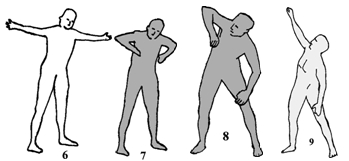
- Arm totally relaxed along with forearm through knee drive. Position exactly like the former, right arms vertically held upward and forearm hanging freely. The first drive of knee sends the forearm upward; later let you whole arms fall relaxed. The second drive of knee sends the whole arm upward; then let just the forearm fall. You can repeat this rhythmically.
- Both forearms relaxed through knee drive. Lateral position. Incline lightly the trunk forward and stretch your arms horizontally toward both sides. Forearms hang freely downward. Move your forearms like pendulums with a simultaneous knee drive (Figure number 10).
- Both forearms relaxed through lateral knee drive. Lateral position with feet in parallel and trunk lightly inclined forward. Stretch horizontally your arms at both sides, your forearms hanging freely downwards. With a knee shortly bent and stretched, drive laterally your body and move your forearms like pendulums. Later you shall be able to practice a continuous oscillation movement through an alternate drive of one knee or another.
- Arms and shoulders relaxed through knee drive. Lateral position, by inclining the trunk forward until the horizontal line, and by letting one’s arms hang freely downward. The first drive of knees moves one’s arms move like pendulums inwards, somewhat crossed. Through repeated drives, you shall make your arms oscillate like hammocks as high as possible (Figures 11 and 12).
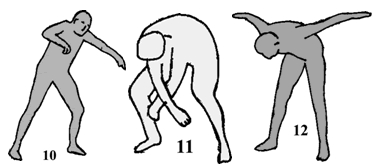
- Both arms and forearms relaxed through knee drives. Lateral position, the trunk inclined forward until the horizontal line, and arms hanging freely downward. Through repeated knee drives, move your arms like pendulums. When your arms reach the horizontal line, keep them fixed in this position, and let your arms continue moving like pendulums, without drives of knees, until rest.
- Shoulders and arms relaxed through inclined trunk rotation. Wide lateral position with the trunk inclined until the horizontal line, with arms hanging freely downward. Move both arms like pendulums upward to right and left, through strong drives given by the trunk during its rotation from right to left; keep the horizontal position and do not bend your knees (Figure number 13).

Legs
13) Thigh relaxed through hip drive. Standing, one leg a little higher than the ground (step, little bench or book). Through drive forward from your hip, move your free leg like a pendulum, in a relaxed way, in the same direction, and later let these oscillations rest. Later you can repeat drives.
14.Thigh relaxed through sliding. Standing, one leg a little higher than the ground. Your free leg leans with the heel on the edge of a chair. When you withdraw lightly your hip backwards, thigh and leg are without support and move freely like pendulums (Figure number 14).
15) Relaxed leg through fall. Raise the right thigh and leg until the horizontal line, hold the thigh with both hands, and let your leg fall and move like a pendulum until rest.
16) Leg relaxed through sliding. Lean the leg with the heel on the edge of a chair. When you withdraw lightly the hip backwards, your foot is without support and the leg moves freely like a pendulum. Your thigh remains in semi-horizontal position.
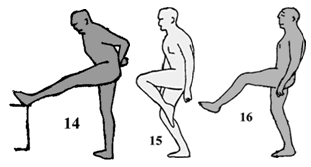
- Leg relaxed through knee drive. Raise one thigh until the horizontal line, and related leg hanging freely. Through drive of knee related to the leg on which you stand, the hanging leg starts to move like a pendulum. Later, through repeated drives, you can get a continuous pendulum-like movement (Figures numbers 15 and 16.)
- Thigh and leg relaxed through knee drive. Raise one thigh until the horizontal line, and related leg hanging freely. Through the first drive of knee, your leg oscillates forward; then, let leg and thigh hanging. Reinforce the oscillation of thigh and leg forward through another drive of knee; when these drives reach “dead end”, let your leg alone move like a pendulum; then, keep the thigh on an almost horizontal position. You can repeat this rhythmically.
- Leg relaxed with thigh raiseed at a side. At attention position, body and arms with no tension. Raise the left thigh toward your side until the horizontal line, and let your leg hang freely downwards. Left hand holds the thigh beneath, near the knee joint. Move like a pendulum your leg through a lateral drive of hips and knee.
Hips and Lumbar Area
20) Hips relaxed through trunk laterally projected by knee drive. Wide lateral position with trunk lightly inclined forward; arms hanging with no tension. Through flexion of left knee, trunk falls to left with certain rotation of shoulders. One you end up the pendulum-like movement of arms, straighten rapidly the left knee and bend at the same time the right knee; this gives rise to a strong drive that launches the trunk to left, passing to vertical position to right (Figures numbers 17, 18 and 19).
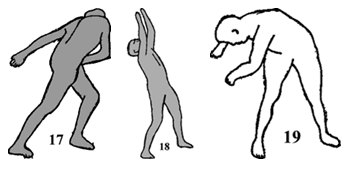
- Relaxed hips rotating the inclined trunk through knee drive. Wide lateral position with trunk inclined forward to left; arms hanging freely and knees lightly bent. When you straighten your left knee and bend your right knee at the same time, the trunk is horizontally driven to right and your arms trace an arc; let your arms move like pendulums until rest. Later you can practice continuously this movement from right to left, and vice versa (Figures numbers 20, 21, and 22).
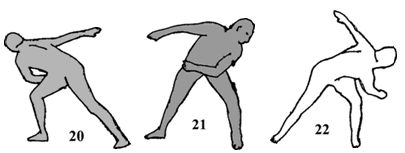
Back
22) Relaxed back through inclination drive. Narrow lateral position with trunk lightly inclined forward, and arms hanging freely. Let trunk fall totally forward, while your arms receive a drive backwards. Through an oscillation of arms forward, your thorax receives a drive toward its initial position. Repeat this rhythmically. Knees must yield very little (Figures numbers 23 and 24).
23) Back relaxed, sitting down position. Sitting down, legs together and stretched. Hand on the back of your neck, elbows quite behind, chest protruding. At once, let head, back, elbows and thorax fall loosely and simultaneously forward.
24) Back relaxed through fall of trunk. Wide lateral position, arms hanging freely, and knees lightly bent. Let trunk fall towards right leg; straighten it and let it fall on left leg; straighten it again and let it fall forward (Figures number 25).
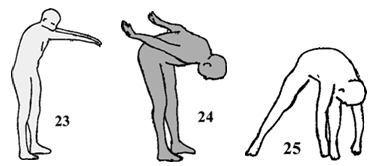
Neck
25) Neck relaxation.
a) Natural position. Through lateral trunk inclination to right and left, let your head fall to both sides alternately.
b) Through trunk inclination forward and backward, likewise let your head fall forward and backward.
c) Through rotation of trunk, by tracing the form of a funnel and keeping the front line of shoulders, make your head rotate freely.
Trunk
26) Trunk relaxed, rotating. Lateral position, arms hanging freely downwards. Let your trunk fall forward and make it rotate very slowly; muscles as loose as possible, yielding lightly with your knees (Figures numbers 26, 27, 28 and 29).

Whole body
27) Whole body relaxed.
a) Natural position, arms high up. Let arms fall loose, vertically (by themselves).
b) The same, but also let the head fall forward.
c)The same, but also let the head and trunk fall forward.
28. As before, but let the body fall loosely (vertically), by relaxing all muscles and through passive knee flexion (Figures numbers 30, 31 and 32).
